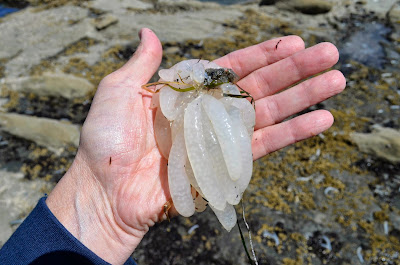The last day of MBFE at OIMB includes some important things. The main one is that every research team gives an oral presentation of their research project, results, and conclusions. It's fun to see what each group did and hear what they learned. In most cases they learned that things don't always go as smoothly as they thought/hoped it would when they started. We had one group all set to carry out a set of experiments, but the larval crabs they needed didn't appear as expected. Another group had some research going in the lab when some of their specimens mysteriously disappeared. Others found it difficult but fun to work in mud in the nearby national research estuary, and others had their own challenges to overcome. That's science!
Before the presentations though, we had one of the best low tides of the entire trip this morning, a -1.7' tide at about 8am. Some of the students took advantage of the low tide for one last visit to the shore. Interestingly the morning dawned gray and misty, but by mid-morning the fog burned off and the clouds moved off. It's almost as if the southern Oregon coast was enticing us to stay and stay and stay.
This is a shot looking south along Lighthouse Beach.
But of course we had to get ready to go, so we met around 11 am and cleaned the lab and packed the MBFE class gear.
After lunch was our final official MBFE event - the student research presentations. Each student participated, and presented to the rest of the class. As I hopped down the stairs of my cottage with projector and computer slung over my shoulder I looked up and saw something you just don't see every day...well, maybe unless you hang out at marine laboratories, even then this is a rarity...lab staff were using a forklift to move the skull of a humpback whale to its resting place just outside of the entrance to the Charleston Marine Life Center.
I had the class empty out of the lab so they could watch too. It was pretty awesome!
When the students came back in and we were ready to start I gave them some introductory guidelines and reminders and then invited the first group to get ready to get started. At this point the entire class came to the front...I was surrounded! Not to worry though, they had gone together and found a memento of the trip for me. I had no idea!
It's a pretty glass sculpture of a ray. They got this for me since I mentioned once in class that my "spirit animal" is an eagle ray, like Mr. Ray from the PIXAR movie "Finding Nemo." That was so thoughtful and kind of them do to this. This will always have a place of honor in my office or home. Thanks everyone!
Once everyone settled down we were ready to get started. Just so you know, this is what it looks like from the front of the room when the MBFE crew is ready to get started:
Front row L-R: Luke, Skyler, Isaac, Eileen, Jennifer, Shannon
Middle row L-R: Rachel S, Devon, Joseph, Arianne, Kelly, Jessica
Back row L-R: Courtney, Rachel M, Danielle
Anyway, we finally started the presentations. Here's one group presenting the results of their project (Presenters L-R: Danielle, Courtney, Rachel M).
After the last presentation we went back over to the Charleston Marine Life Center and Dr. Young who was already there offered to take this group photo - Front row L-R: Joseph, Isaac, Skyler, back row: Rachel M, "Dr. H", Courtney, Luke, Danielle, Devon, Eileen, Arianne, Jessica, Rachel S, Kelly, Jennifer, and Shannon. Oh, yeah, and Orcinus orca in the background.
From there we decided to try for one more group shot, this one by the main entrance to OIMB - L-R: Courtney, Jessica, Rachel M, Arianne, Kelly (back), Danielle, Isaac (front), Eileen, Shannon, Rachel S, Joseph, Skyler, Devon (standing), Luke, Jennifer.
Here are a few shots of things that students will always remember about their time in MBFE at OIMB.
We wait in line and the most excellent dining hall staff serves each student.
Some MBFE students enjoy dinner...sometimes they even let a guy of two sit here, but apparently NOT TODAY - Skyler and Isaac sulk in the background (just kidding). Anyway, Jessica, Arianne, Courtney, Danielle, Rachel M, and Kelly enjoy our last dinner at OIMB - a Hawaiian themed meal that sent at least some MBFE students back for seconds! The food at OIMB is good, too good, I know I put on some unneeded pounds. Sigh.
After dinner we (and when I say "we" I mean the students) finished cleaning the lab and they helped load the class gear into my van. Yep, MBFE is really ending.
And this is what it means when they say, "Leave it better than you found it." OK, actually it looked pretty much this good when we arrived, but we left it in good shape. It's always good to leave people clapping.
What's next? I'm afraid you'll just have to wait until Spring 2017 for the next offering of MBFE. Until then, stay happy, and don't turn your back on the sea.
The MBFE class really was top-notch.
Some students left already and the rest of us will leave tomorrow. So long OIMB, and thanks for the great support and experiences!






















































